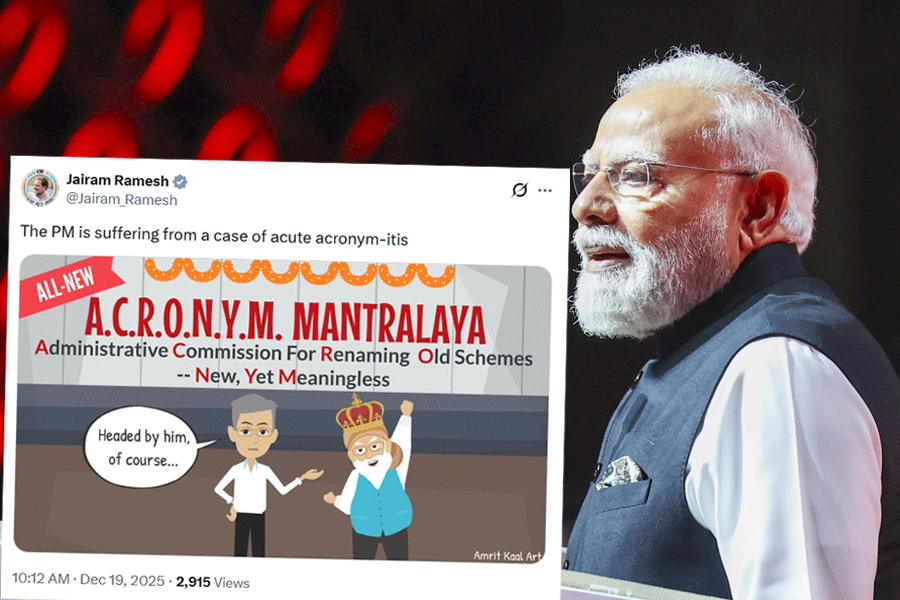Remakes are never their own thing although sometimes they can affect at what they will never be; they are a pretence, often counterfeit, often plain farcical. The one purpose remakes may yet serve is to remind us of the original. June 24 occasioned such a reminder; Prime Minister Narendra Modi’s ‘Dilli ki doori, dil ki doori’ session with Kashmiri entities was a pyrrhic attempt at a remake whose use-before date has quickly expired.
This is how the original played out. November 2, 1947, Lal Chowk, Srinagar. A lofty stage, a large congregation. The ink is still moist on the Instrument of Accession, Article 370 of the Constitution will take another two years to be written in (and another seventy to be struck out). Sheikh Mohammed Abdullah turns fondly to Jawaharlal Nehru, Kashmiri Musalmaan to Kashmiri Pandit, and sings out the vows in Amir Khusro’s verse:
“Mun tu shudam/ Tu mun shudi;/ Man tan shudam/ Tu jaan shudi;/ Takas na goyad bod azeen/ Mun deegaram/ Tu deegaree.” (“I am You and You are me; I am your body, You are my soul; So none should hereafter say, I am someone and You someone else.”)
What was to follow would knock the stuffing off that sublime song and render it a tattered feast for vultures.
That is how we began, in poetry. This is where we are now, in the ringing absence of it and worse. Recall just some of what those convened around the prime minister’s table have publicly said of each other recently, recall the circumstances they have wreaked on each other, or have expressed the desire to wreak.
All of what briefly came to transpire on June 24 is a remake; it’s all happened before, and happened time and again.
Here’s a taste of the first souring. Sheikh Abdullah is irked that Gopalaswami Ayyangar, Nehru’s minister for Kashmir affairs, underlines the impermanence of Article 370. He writes to Nehru. “Shri Ayyangar stated that Article 370 was not a permanent feature of the Indian Constitution and ‘when the time was ripe’ the provision could be wiped off the Constitution... This clearly shows that even though assurances were given to us... such assurances came with a good deal of mental reservations.” No assurance to the contrary is forthcoming from Nehru. This is mid-1953.
The Sheikh activates his agitations and is quick to get the National Conference to propose an “end to the uncertainty” — a call for plebiscite with the option of independence written in.
Nehru responds with affront. He writes to the Sheikh: “You know that the question of Kashmir has had not only a logical appeal for me but also a strong emotional one. But I can suppress my emotion, if necessary, if logic demands that... Thus far I have proceeded on the basis of friendship and confidence in you and have been vain enough to expect the same from you... To me it has been a major surprise that a settlement arrived at between us should be bypassed or repudiated, regardless of the merits. That strikes at the root of all confidence... No treaty would be worth the paper it is written on, if it was to be repudiated soon after...”
The relationship is fast funnelling down the vortex of suspicion. On the night of August 8, 1953, the Sheikh is dismissed from office and bundled into jail for conspiracy. He would remain behind bars until just a month before Nehru’s death in May 1964. It is during that time, during the long chaining of the “lion of Kashmir” that the Constitution of Jammu and Kashmir gets drafted and adopted; the Sheikh had no role to play.
But the show proceeded. The bonhomie of 1947 utterly unmade, remakes were in the making. Sheikh Abdullah would himself come to play a role in the first one. He would sign a power accord with Indira Gandhi in 1975 and become chief minister again. But this remake was to give way to another, and many yet would follow. In 1984, the Sheikh’s son and successor, Farooq Abdullah, is toppled in a palace coup effected under the auspices of Rajiv Gandhi, then general secretary of the ruling Congress. Two years later, Rajiv and Farooq would turn out as dual-lead of another remake; they would hold hands at a rally in Jammu and utter sweet things of each other that time and cynicism have now completely obliterated. Anyhow, Farooq is chief minister again.
In the three-and-a-half decades since, this is how the lead cast of recurrent remakes has looked: Farooq Abdullah. A long and tumultuous interregnum presided over for the better part by Jagmohan. In 1996, Farooq Abdullah again. Then Mufti Mohammed Sayeed in the company of the Congress. Then the Congress’s Ghulam Nabi Azad in the company of Mufti Mohammed Sayeed. Then Omar Abdullah. Then Mufti Mohammed Sayeed again, this time in the company of the BJP. Then, upon his passing, Mehbooba Mufti in the company of the BJP. And then, poof! She may be written down in history as the last chief minister of the state of Jammu and Kashmir as it once used to be. She remains too, with the Abdullahs and sundry others, part of the exclusive club labelled the Gupkar Gang by those she sat across on June 24.
In that time, in those three-and-a-half decades of remaking and remaking redux, these few things too came to be.
A murderous drift took hold of the Kashmir Valley and shook the foundations of state and society alike. The gun-blazoned “aazaadi” insurrection invited a jackbooted military crackdown, but the crossfire brought upon the Pandits a harsh, and yet unresolved, banishment. The hurricane barrelled into the Valley’s core and its far corners and deposited them in tattered tent shanties across the Banihal, India’s largest, and probably most intractable, internal displacement.
Kashmir was turned into a ghastly theatre of discord, destruction, disruption and wanton death, such that other than the pitiless brochure cliché of paradise, there remained nothing paradisal about it. A people more battered and brutalized would be hard to find. The subcontinental collaboration towards the reduction of what it means to be a Kashmiri, in body and in soul, remains a work in progress. It is a project so engulfing that you may be excused if you omitted to remember that a war too was fought — another one — over Kashmir’s northern flank in the summer of 1999, the first military eyeball-to-eyeball between nuclear powers.
What’s left of Kashmir to do a remake with? And where have Kashmiris figured in it, if ever? What was the gathering of June 24 on about? There were those there who’d travelled down from demands of secession or self-rule or, at the very least, autonomy. The Sheikh’s distrustful prophecy over Article 370 is now the truth. There is no state that “cornerstone” guarantee can be applied to for there is no state anymore. The demand that the state be restored, moth-eaten as it would be, and a throne be readied, however sawn and stunted, is just how farcical and fake the nature of this latest remake is.











